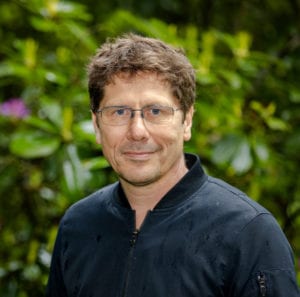Prof. Dr. Hanno Gottschalk
Professor of Stochastics at the Bergische Universität Wuppertal
and expert for autonomous driving
»The future certainly lies in a clever combination of public transport and individual transport as feeders«
Hanno Gottschalk is a professor of stochastics at the University of Wuppertal and an expert on autonomous driving. Learn what he hopes to achieve with self-driving cars and what research challenges lie ahead.

© University of Wuppertal
What is autonomous driving and why isn’t it called automated driving?
When we use the term autonomous driving, we mean that a car is able to steer itself, orient itself in its surroundings and move in the direction of a predefined destination following road traffic regulations. The human being can lean back comfortably. But more correctly, it should probably be called automated driving. In Aristotle, autonomy is the condition from which an individual can decide freely and therefore act morally responsibly. This is not an accurate description of what AI does according to the current state of the art. As in the name »artificial intelligence,« the term autonomous driving, therefore, aims to exaggerate the technology by ascribing human attributes to it. Not a good development when inaccurate language conveys problematic messages.
Where are the advantages of autonomous driving and where can autonomous driving be used in a meaningful way?
I can think of an awful lot of great applications for fully automated driving – when cars roll out of garages on demand and all the parked cars disappear from the street scene. Or that I could quickly correct a bachelor’s thesis on the way to work. That would be a dream. Mobility for children and older people could also develop positively. My parents and their friends no longer party at night because no one wants to drive in the dark. They could then do that again. Or children of working parents could be driven to training in the afternoon – a pure wellness program for mothers and fathers.
But as a society, we have to observe what is happening and discuss the development publicly and intervene when things go wrong. Imagine that the cost of transportation drops to the point where every little thing is carted around individually, resulting in constant road congestion. Automation alone is no substitute for a sensible transportation concept. The future certainly lies in a clever combination of public transportation and individual transportation as a feeder. Last but not least: Currently, driving is a professional activity. In the transition to automated driving, we need a perspective for the employees in this sector. Since they do not have a strong lobby, the public must pay all the more attention to ensure that the new business models of some are not paid for with the misery of others.
Can you describe the challenges in developing and deploying autonomous systems?
The basic technology for automated driving already exists. But reliability and safety are a problem. So-called AI is extremely powerful in closed worlds, where there are only a handful of options for action. Open worlds, such as in urban traffic, present very different challenges. That’s why I believe we will see automated driving first on highways and other regulated road situations. Car-to-car communication with 5G would significantly increase safety once it is rolled out across the board. The problem, apart from data protection and IT security, is the transition phase: Will the owners of cars with new technology be much safer than the drivers of old vehicles? Will there be demands for people to be allowed on the road only with electronic positioning systems built into their cell phones to improve recognition by cars? Or is it the fault of those who leave their cell phones at home if they get run over? For me, these are dystopian ideas. That’s why I would prefer it if we could manage to enable automated driving using vehicle sensor technology and image recognition methods alone. For this, we need to understand exactly when image recognition or the interpretation of lidar and radar sensors with deep neural networks reach their limit. And so we are back to the central problem: reliability and safety of AI.
Prof. Dr. Hanno Gottschalk grew up in Leverkusen and studied mathematics and physics in Freiburg and Bochum. After completing his doctorate in mathematics at the Ruhr University in 1999, he researched as a DAAD scholarship holder at the University ‘La Spienza’ in Rome. This was followed by three years as a PostDoc at the University of Bonn. There he habilitated in mathematics in 2003 and became a university lecturer in 2006. In 2007, he temporarily left the academic career and worked as Core Competency Owner for Probabilistic Design in Gas Turbine Engineering at Siemens Energy. After a call to the Bergische Universität Wuppertal, Hanno Gottschalk has been teaching and researching as a professor of stochastics in Wuppertal since 2011. In addition to modeling the reliability of mechanical components, Prof. Gottschalk researches the uncertainty and errors of artificial intelligence. In June 2018, he became the founding director of the Interdisciplinary Center for Machine Learning & Data Analytics with Anton Kummert.